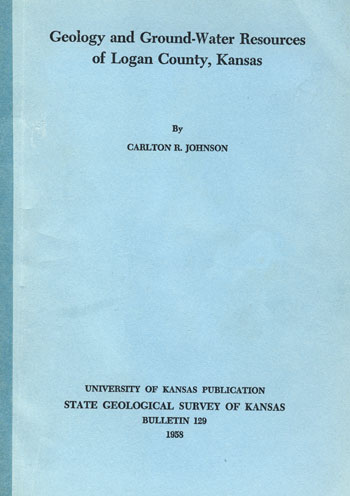Geology and Ground-water Resources of Logan County, Kansas
By Carlton R. Johnson, U. S. Geological Survey

Originally published in 1958 as Kansas Geological Survey Bulletin 129. This is, in general, the original text as published. The information has not been updated.
You may also wish to visit our web site on the Logan County geologic map.
Abstract
This report describes the geology and ground-water resources of Logan County in the High Plains of northwestern Kansas. The county has an area of 1,073 square miles, divisible into upland plains comprising about 35 percent of the county, flood plains along Smoky Hill River and tributaries, and dissected "pediment" slopes. The streams drain eastward and southeastward at gradients ranging from 14 to 24 feet per mile. Lakes in the county have been formed naturally by subsidence, deflation, and alluviation and artificially by damming small valleys.
The Pierre shale and Niobrara formation of Cretaceous age underlie the county and are exposed along the major valleys. These rocks are intricately faulted. The Ogallala formation, of Pliocene age, which underlies the upland plain, was deposited on the eroded surface of the Cretaceous rocks. The configuration of this surface perhaps was influenced by regional structure. Test drilling indicated distinct pre-Ogallala drainage channels trending generally northeast in the northern upland and southeast in the southern part of the county.
Ground water is one of the most important mineral resources of Logan County. The major aquifer in the northern upland is the Ogallala formation, which yields moderate to abundant amounts of hard calcium magnesium bicarbonate water to livestock, domestic, public-supply, and irrigation wells. Where the formation occupies pre-Ogallala valleys, its saturated thickness is sufficient to permit development of large wells for public supply and irrigation. In the northern upland, ground water moves eastward down a gradient of 10 feet per mile. The direction of movement is primarily dependent on the general configuration of the surface of the pre-Ogallala rocks, which are relatively impervious and confine the ground water to the permeable beds of the Ogallala formation. Ground water is scanty in the Ogallala formation in the southern upland and is very scarce in areas between the edge of the Ogallala formation and the flood plains of the major streams, where wells are supplied chiefly from Pleistocene alluvial deposits in small valleys. Wells drilled into the Dakota formation or the jointed Niobrara formation adjacent to faults probably will yield water of quality suitable for livestock in places to which water now is hauled for this purpose. Pleistocene deposits in flood-plain areas yield moderate to abundant supplies of water to livestock and domestic wells.
The chemical quality of the ground water in the county is related to geologic source. Five distinctive types of water are characteristic of the Ogallala formation, Pierre shale, Niobrara formation, Codell sandstone zone of the Carlile shale, and sandstone of the Dakota formation, respectively. The amount of dissolved solids in water from the Ogallala formation seems inversely related to the thickness of the water-bearing materials. The water in the Ogallala formation is hard but generally suitable for irrigation.
Recharge to the northern upland is estimated at almost 3,000 acre-feet per year. Factors involved in the computation include. average gradient through the estimated cross-sectional area of permeable rocks at the east county line and a value for the permeability of the Ogallala formation, which is based on aquifer tests.
Ground water in Logan County is developed principally for livestock and domestic use. The amount of water developed for irrigation is about 1,000 acre-feet per year and probably will increase in the northern upland area in future years.
Kansas Geological Survey, Geology
Placed on web Dec. 10, 2007; originally published May, 1958.
Comments to webadmin@kgs.ku.edu
The URL for this page is http://www.kgs.ku.edu/General/Geology/Logan/index.html